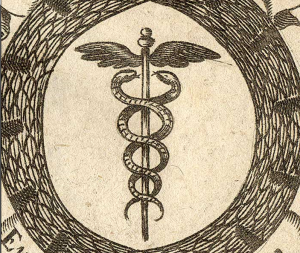Snakes in the Psyche
In Amy Hardie’s recent documentary film,The Edge of Dreaming, (reviewed yesterday) she encounters a huge snake that devours her during a shamanic healing. Out of this experience, she recovered from what appeared to be a fatal lung disease. Why the snake?
Perhaps the commonest dream symbol of transcendence is the snake, as represented by the therapeutic symbol of the Roman god of medicine Aesclepius, which has survived to modern times as a sign of the medical profession. This was originally a nonpoisonous tree snake; as we see it, coiled around the staff of the healing god, it seems to embody a kind of mediation between earth and heaven.
Carl Jung, Man and His Symbols, page 153
The serpent is the age-old representative of the lower worlds, of the belly with its contents and the intestines
Carl Jung (source)
From:
Chthonic: From Beast to Godhead
Vadge Moore
The Uroboros snake eating its own tail is a perfect illustration of how chthonic can represent both the creative and destructive aspects of nature. The Uroboros is the unity of life and death in which all things that arise into existence must descend back into the void. Author Eric Neumann, in his book The Origins and History of Consciousness writes, “The unconscious life of nature, which is also the life of the Uroboros, combines the most meaningless destruction with the supreme meaningfulness of instinctive creation; for the meaningful unity of the organism is as ‘natural’ as the cancer which devours it.”
The chthonic process is an occult “awakening” that includes the very lowest instinctual elements of the human psyche leading to the very highest elements. It is the base, primordial material that the psyche needs in order to evolve and grow. Chthonic is the soil, the fertilizer, and the dark, primitive unconscious material that can turn the beast into a god. Chthonic is depicted in all myths as the Underworld, Hell or Hades. Jungian author James Hillman considers this Underworld to be the residence of the soul, the place the hero must descend in order to find his essence.
The Uroboros snake eating its own tail is a perfect illustration of how chthonic can represent both the creative and destructive aspects of nature. The Uroboros is the unity of life and death in which all things that arise into existence must descend back into the void. Author Eric Neumann, in his book The Origins and History of Consciousness writes, “The unconscious life of nature, which is also the life of the Uroboros, combines the most meaningless destruction with the supreme meaningfulness of instinctive creation; for the meaningful unity of the organism is as ‘natural’ as the cancer which devours it.”

